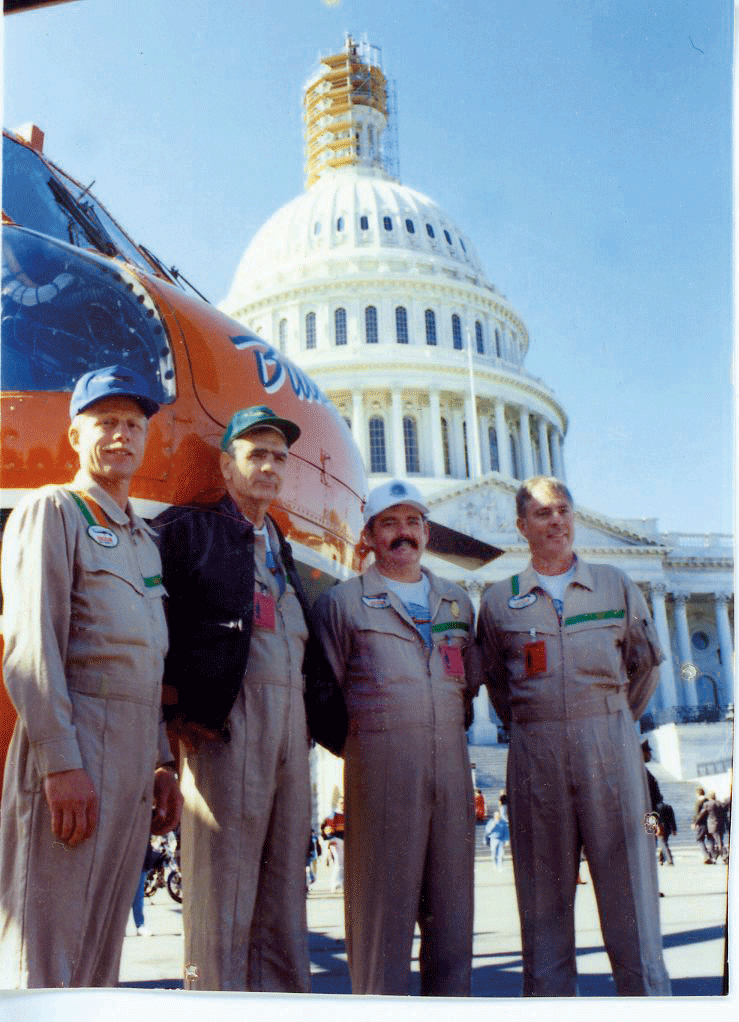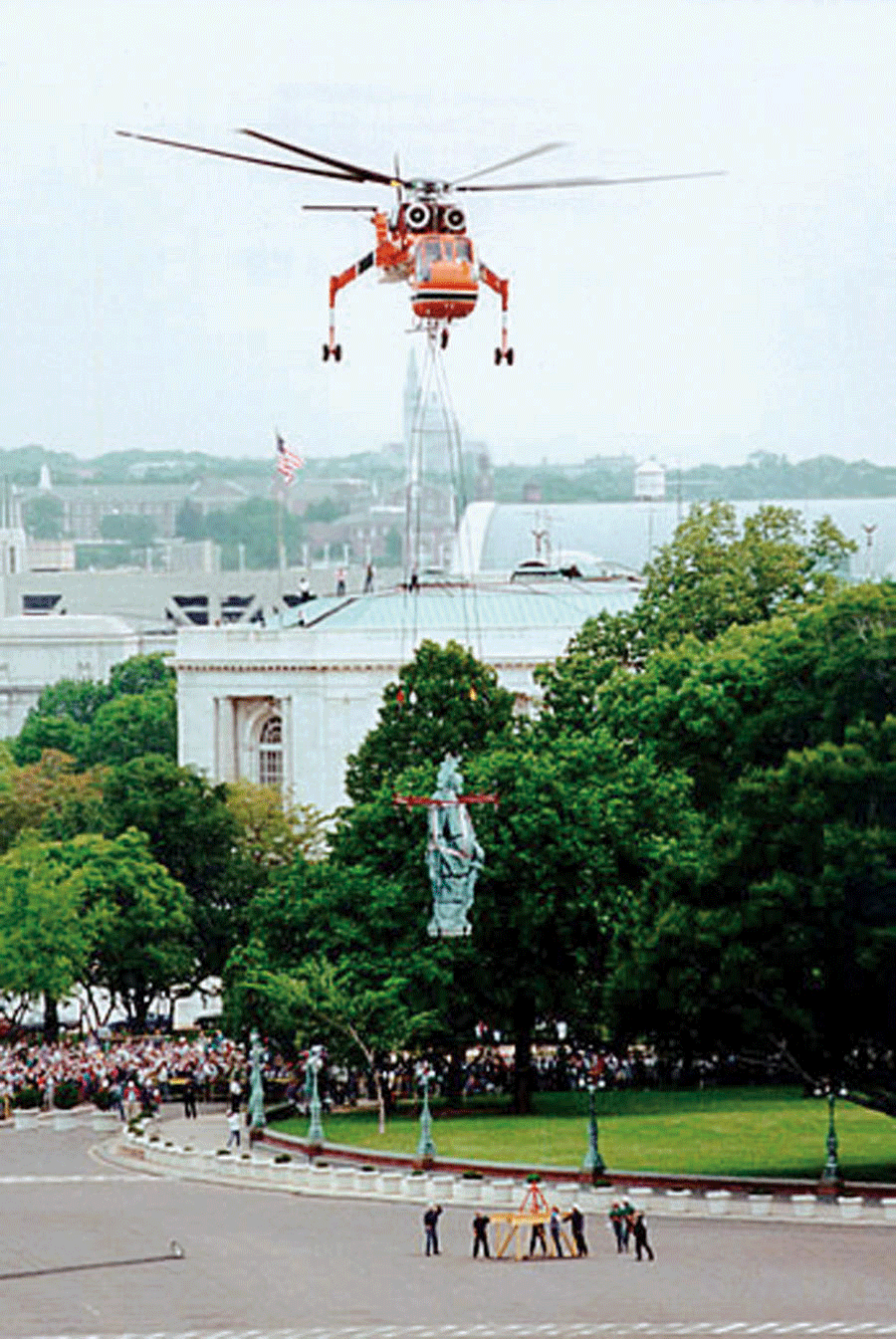Helicopter pilots, SDSU grads flew refurbished Freedom back to her U.S. Capitol dome perch
It was October 1993 that South Dakota State University alumnus Larry Pravecek ’61 returned the statue Freedom to her spot atop the U.S. Capitol. Five months earlier, fellow SDSU graduate Max Evans ’69 lowered the statue for refurbishing after it rested on the Capitol for 130 years.
Pravecek, who now lives in Winner, and Evans, who now calls Columbus, Ohio, home after growing up in Hermosa, were working at Oregon’s Erickson Air Crane Co. After graduating with degrees in animal husbandry and mechanized agriculture, respectively, Pravecek and Evans learned to fly helicopters in the U.S. Army and pursued that career path. When tasked with moving Freedom—which stands 19 feet 6 inches and weighs 7 tons—they knew it would be a little different than their previous assignments.

The crew who was tasked to move Freedom was, from left, Max Evans ’69, Larry Pravecek ’61 and copilots John Long and Dave Cox.
“For us, it was a normal job, but with the added publicity and the type of product we were moving—that added a lot of anxiety, pressure,†Pravecek said. “Once we got in the crane, it was just like any other job. When you start flying from the backseat, you can’t scratch your nose or anything, you just have to fly.
“President Clinton and Vice President Gore were there as were about 25 senators. We dusted them pretty good when we landed.â€
Erickson was chosen due to its ability to raise and lower large objects, such as towers, and because it had Skycrane S-64 helicopters. The helicopters were unique because there were two pilots in the front and two in the rear. Those rear pilots were Pravecek and Evans.
“Larry developed that area,†Evans said. “It gave you the view like a backhoe or a crane operator so you could see how you were handling the load.â€
By the time moving Freedom came along, the pilots had been using the Skycrane for nearly 20 years.
“We had built power lines across the country, carried logs, you name it,†Evans said. “In Toronto, we put up the final 300-some feet of the CN Tower (the tallest tower in the western hemisphere).
“You needed to have experience in that line of work, and it cost a lot of money to train people,†he continued. “We were the only ones doing the aft seat work, that precise work. Larry would work two weeks and then I’d work two weeks.â€
But when approached about moving Freedom, “we said we could it do it in 10 minutes each time. The architect of the project thought we were crazy,†said Pravecek.
Evans recalls hardly anyone other than fellow workers and the Capitol preservation committee in attendance when he lowered Freedom May 9, 1993.
“We didn’t have any practice but we had done similar work all year,†Evans said. “I was more anxious about the weight of it. No one was sure how it would hang (from the helicopter) after removal.â€
The statue had been raised 8 inches to place a ring underneath for help transporting it. Following refurbishment, workers had to align 48 bolts to reconnect Freedom. In addition to each bolt having a mark on the ring for placement, there was also a cone built on the base to center the statue.
 “The contractor also realized we had 40 minutes to install it so he asked if I could fly off with the rigging and nylon straps rather than have the workers take them,†said Pravecek, noting he had to hover while waiting for the workers to remove the transportation materials. “They kept telling me to hold it steady, but when you’re carrying something like that, that’s not the easiest thing to do for that long of time.â€
“The contractor also realized we had 40 minutes to install it so he asked if I could fly off with the rigging and nylon straps rather than have the workers take them,†said Pravecek, noting he had to hover while waiting for the workers to remove the transportation materials. “They kept telling me to hold it steady, but when you’re carrying something like that, that’s not the easiest thing to do for that long of time.â€
Particularly with roughly 52,000 people in attendance watching his every move.
The task continues to bring them fond memories.
With several family members, Pravecek visited the Capitol in 2012.
“While on the tour, we were told about how Freedom was moved by helicopter pilots,†he said. “At a break, I told the guide I was one of those pilots. She had her picture taken with us.
“It’s something we won’t forget,†continued Pravecek, who was selected to the South Dakota Aviation Hall of Fame in 2008 and has been presented the Wright Brothers Master Pilot Award. “We can drive around the country and see a lot of our handiwork, but it’s the most notable one.â€
Matt Schmidt







